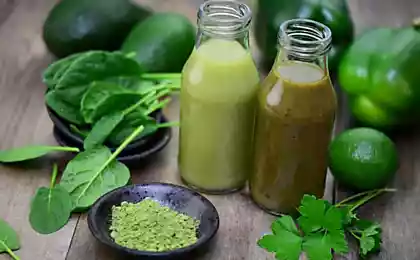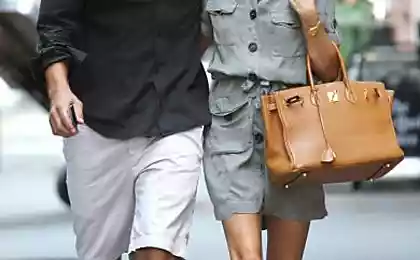1429
All you need to know about lettuce and leafy greens
Do not underestimate the beneficial properties of green salads and perceive them only as decoration festive dishes. These succulent leaves contain vitamins all groups, a large number of trace elements (iron, calcium, potassium, phosphorus, magnesium, selenium), digestible protein and fiber, and absolutely no fat.
Lettuce Salad
Gentle curly leaves grow rosette and have a weakly pronounced sweet taste. They are easy to deform and fade quickly, so the lettuce used in fresh form, breaking hands leaves to fill a better light sauces based on olive oil. This is one of the most ancient types of salad, many kinds of salads sheet - his direct descendants
.
Iceberg lettuce
The leaves on the mind like a normal lettuce, but they are collected in small round kapustopodobnye kochanchiki. lettuce leaves are very delicate, so they do not cut and tear the hands, or even put in the whole dish.
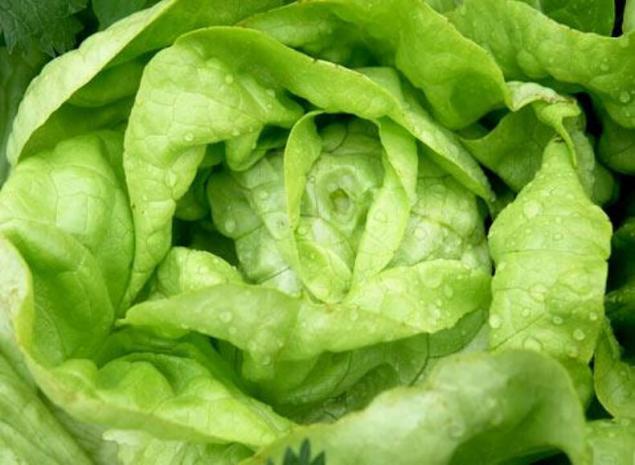
Iceberg, Ice salad
According resembles small, dense heads of cabbage with a light-green leaves. Scientifically this lettuce called krispheds - "crunchy head," and, indeed, an iceberg is very crispy. Salad does not have a pronounced taste, so well with spicier varieties of greenery.
He was taken farmers in California in the 20s of the last century, tender lettuce transported to neighboring states, peppered cabbage crushed ice, hence the name "ice-salad" or "iceberg».
Roman, Roman, Roman salad
Large loose elongated cabbage up to 30 cm with a very crispy white and green leaves. The taste of Roman lettuce slightly spicy and very juicy, lettuce well regulates water metabolism and increases the level of hemoglobin in the blood.
Chicory salad
Juicy white-yellow or greenish leaves collected in the oblong cabbage 15-20 cm in length, have a bitter taste. Chicory is grown in the dark, the leaves were bright; than the green leaves of chicory, the more bitterness in them. On the palate, it combines perfectly with the herbs, and form dense leaf resembles the boat, so they are often used as plates, salad.
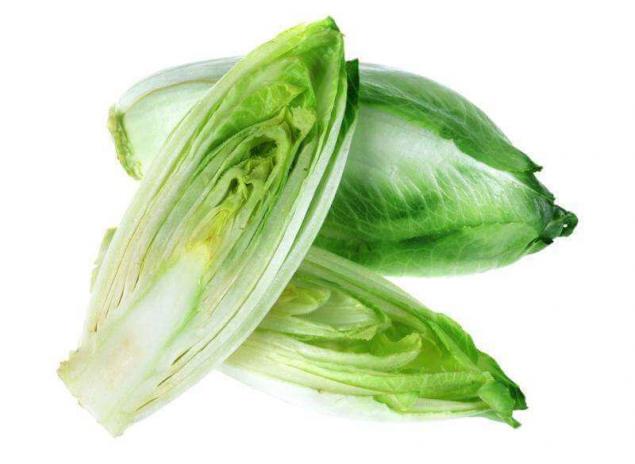
Radichchio, red chicory
Small cabbage have color from white-pink to deep purple and dark red with white veins. The leaves look very decorative, they are used in fresh form, mixing with other varieties salata.Na radichchio taste quite bitter, so it is suitable for filling with honey, citrus or fruit juice.
Endive,
Frise Iceberg lettuce with a specific bitter taste. Broad-leaved called eskarol, it is similar in taste to its ancestor - chicory. Friese - a curly endive, which has a very beautiful carved leaves. Endive all varieties grown in the dark to enhance the production of specific substances "intibin" which gives leaves a bitter taste and improve appetite. While lettuce is growing, its leaves are linked together to preserve the core of the tender and light, and the tips of the leaves acquire a bright color. Delicate bitterness and fresh taste of endive and frieze well with citrus, garlic.
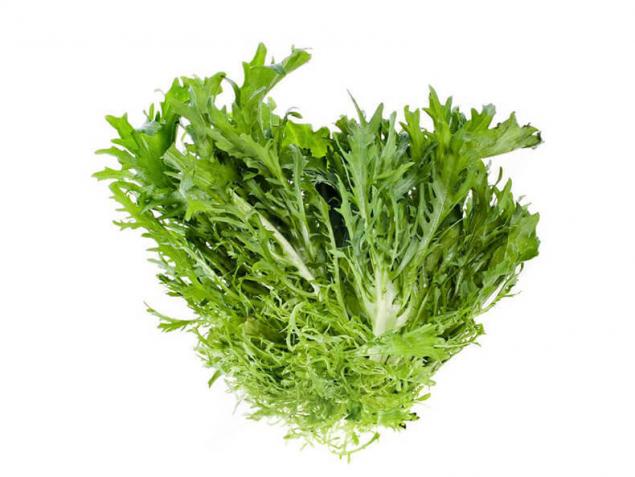
Oaklif, oak salad
This variety gets its name from the fact that is shaped like oak leaves. There are varieties with green and red and green leaves. Gentle slightly nutty flavor of this salad is not to score too spicy ingredients. Salad goes well with avocado. These leaves are very delicate, they need to be used immediately, because they quickly fade.
Lollo Rosso, red lettuce
This Italian cultivar lettuce is based on the lettuce, but its leaves have wavy bright colored coloring in green and burgundy tones. Taste quite intense with a slight bitterness.
Lollo Biondo
Another green salad leaf, this descendant of lettuce like a Lollo Rosso, but the leaves are blue-green, are collected in loose rosettes. These leaves have a slight bitterness, perfectly combined with the dressing with lemon juice.
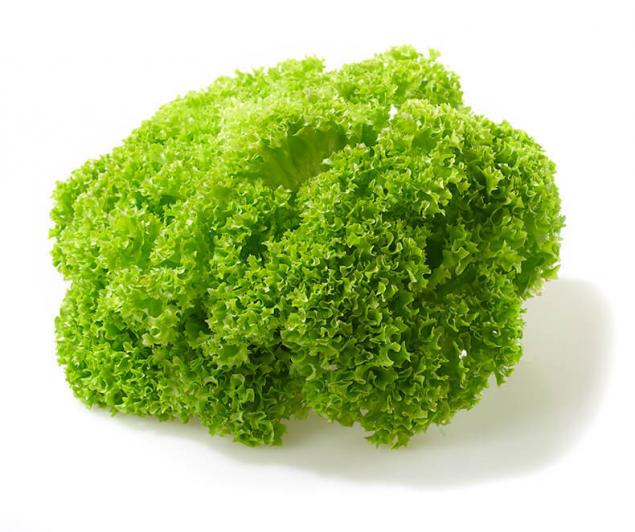
Frillis
Lettuce, very similar to lettuce, but with corrugated leaves with pointed tips. It is often sold in pots, because the delicate crispy leaves quickly wither. Use frillis possible in all recipes instead of the iceberg.
Corn, corn salad, corn salad
These small dark-green leaves with a slight sheen, gathered in small "roses" in ancient Rome were considered an aphrodisiac. They have a delicate flavor and a light spicy and slightly tart flavor that goes well with onions, nuts, citrus.
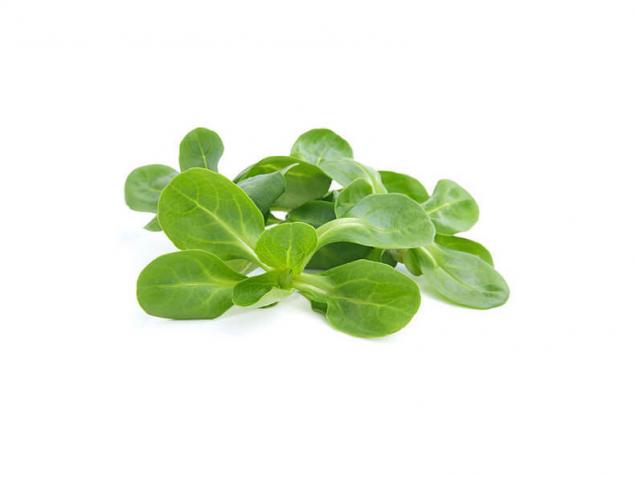
Watercress salad
In appearance and taste similar to corn, but its leaves are smaller and piquant taste and a sharper. It is unclear to whom, and for what reason it occurred to call it "bug-infested seed", but it was under this name maloappetitnym he was known in Russia. In fresh garden cress in salads.
Arugula
By type of arugula leaves similar to dandelion greens. The most delicious young leaves, which are disrupted in the spring and early summer, they give salads and snacks spicy taste with pepper walnut shade. Spicy leaves with sour-spicy taste and a high content of mustard oil has long been very popular in the Mediterranean region, they are perfectly combined with tomatoes, garlic.
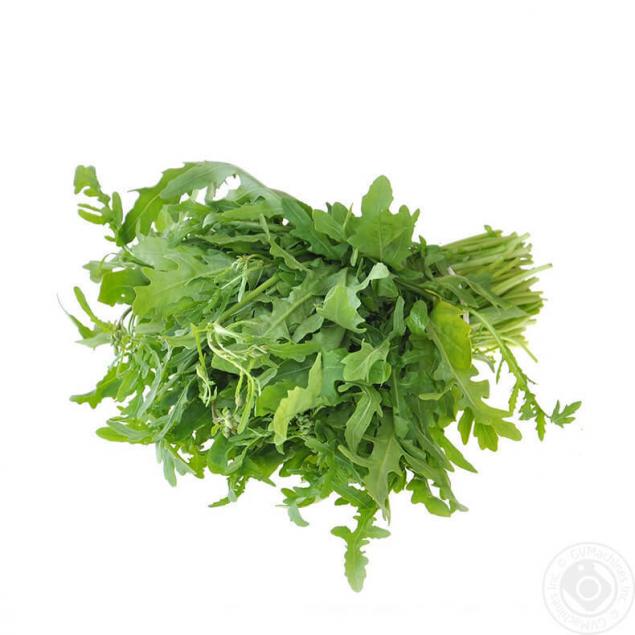
Other greens for salads
Chinese cabbage
This plant belongs to the cabbage family, but is often used as a salad. There Kochan and sheet form. Kochan with juicy crisp leaves with a neutral taste used in salads in combination with other herbs.
Dandelion
In the food use only young leaves, which have a bitter taste, and mix well with neutral varieties of salads and vegetables. For the filling is good peanut oil or lemon juice.
Spinach
Young spinach leaves very tender and almost tasteless, and mature leaves become dense structure and a pleasant light taste. In these fresh crisp leaves are used in salads, smoothies, nuts.
Sorrel
Young leaves can be added to salads with spinach, fragrant herbs, fresh vegetables.
Chard, leaf beet
The species of beets, which are edible stems and leaves, but not rhizome. This ancient plant is cultivated in Babylon, it has a very decorative rosettes of large colored leaves flat or wavy shape. Young leaves are added to green salads.
Pak-choi, Chinese cabbage
This relative chard, popular in Asian cuisine. Kochan consists of a thick, succulent leaves with a white base, which tastes like Chinese cabbage, but more juicy and spicy, and dark green tips with a tart taste. The tips of the leaves are torn, and the white part cut into strips and seasoned sharp, spicy sauces.

Salads in cooking
Do not underestimate the beneficial properties of green salads and perceive them only as decoration festive dishes. These succulent leaves contain vitamins all groups, a large number of trace elements (iron, calcium, potassium, phosphorus, magnesium, selenium), digestible protein and fiber, and absolutely no fat.
100 g of lettuce contains only 13 calories! The ideal product for those who care about the health and preserves the shape. And if you feel that a green salad - it's boring, look at this gorgeous range, your imagination and experiment, because all kinds of salads are perfectly combined with each other and with dozens of other products! Excellent company for salads - fresh vegetables, nuts and seeds, citrus fruits.
Lettuce Salad
Gentle curly leaves grow rosette and have a weakly pronounced sweet taste. They are easy to deform and fade quickly, so the lettuce used in fresh form, breaking hands leaves to fill a better light sauces based on olive oil. This is one of the most ancient types of salad, many kinds of salads sheet - his direct descendants
.

Iceberg lettuce
The leaves on the mind like a normal lettuce, but they are collected in small round kapustopodobnye kochanchiki. lettuce leaves are very delicate, so they do not cut and tear the hands, or even put in the whole dish.

Iceberg, Ice salad
According resembles small, dense heads of cabbage with a light-green leaves. Scientifically this lettuce called krispheds - "crunchy head," and, indeed, an iceberg is very crispy. Salad does not have a pronounced taste, so well with spicier varieties of greenery.
He was taken farmers in California in the 20s of the last century, tender lettuce transported to neighboring states, peppered cabbage crushed ice, hence the name "ice-salad" or "iceberg».
Roman, Roman, Roman salad
Large loose elongated cabbage up to 30 cm with a very crispy white and green leaves. The taste of Roman lettuce slightly spicy and very juicy, lettuce well regulates water metabolism and increases the level of hemoglobin in the blood.
Chicory salad
Juicy white-yellow or greenish leaves collected in the oblong cabbage 15-20 cm in length, have a bitter taste. Chicory is grown in the dark, the leaves were bright; than the green leaves of chicory, the more bitterness in them. On the palate, it combines perfectly with the herbs, and form dense leaf resembles the boat, so they are often used as plates, salad.

Radichchio, red chicory
Small cabbage have color from white-pink to deep purple and dark red with white veins. The leaves look very decorative, they are used in fresh form, mixing with other varieties salata.Na radichchio taste quite bitter, so it is suitable for filling with honey, citrus or fruit juice.
Endive,
Frise Iceberg lettuce with a specific bitter taste. Broad-leaved called eskarol, it is similar in taste to its ancestor - chicory. Friese - a curly endive, which has a very beautiful carved leaves. Endive all varieties grown in the dark to enhance the production of specific substances "intibin" which gives leaves a bitter taste and improve appetite. While lettuce is growing, its leaves are linked together to preserve the core of the tender and light, and the tips of the leaves acquire a bright color. Delicate bitterness and fresh taste of endive and frieze well with citrus, garlic.

Oaklif, oak salad
This variety gets its name from the fact that is shaped like oak leaves. There are varieties with green and red and green leaves. Gentle slightly nutty flavor of this salad is not to score too spicy ingredients. Salad goes well with avocado. These leaves are very delicate, they need to be used immediately, because they quickly fade.
Lollo Rosso, red lettuce
This Italian cultivar lettuce is based on the lettuce, but its leaves have wavy bright colored coloring in green and burgundy tones. Taste quite intense with a slight bitterness.
Lollo Biondo
Another green salad leaf, this descendant of lettuce like a Lollo Rosso, but the leaves are blue-green, are collected in loose rosettes. These leaves have a slight bitterness, perfectly combined with the dressing with lemon juice.

Frillis
Lettuce, very similar to lettuce, but with corrugated leaves with pointed tips. It is often sold in pots, because the delicate crispy leaves quickly wither. Use frillis possible in all recipes instead of the iceberg.
Corn, corn salad, corn salad
These small dark-green leaves with a slight sheen, gathered in small "roses" in ancient Rome were considered an aphrodisiac. They have a delicate flavor and a light spicy and slightly tart flavor that goes well with onions, nuts, citrus.

Watercress salad
In appearance and taste similar to corn, but its leaves are smaller and piquant taste and a sharper. It is unclear to whom, and for what reason it occurred to call it "bug-infested seed", but it was under this name maloappetitnym he was known in Russia. In fresh garden cress in salads.
Arugula
By type of arugula leaves similar to dandelion greens. The most delicious young leaves, which are disrupted in the spring and early summer, they give salads and snacks spicy taste with pepper walnut shade. Spicy leaves with sour-spicy taste and a high content of mustard oil has long been very popular in the Mediterranean region, they are perfectly combined with tomatoes, garlic.

Other greens for salads
Chinese cabbage
This plant belongs to the cabbage family, but is often used as a salad. There Kochan and sheet form. Kochan with juicy crisp leaves with a neutral taste used in salads in combination with other herbs.
Dandelion
In the food use only young leaves, which have a bitter taste, and mix well with neutral varieties of salads and vegetables. For the filling is good peanut oil or lemon juice.
Spinach
Young spinach leaves very tender and almost tasteless, and mature leaves become dense structure and a pleasant light taste. In these fresh crisp leaves are used in salads, smoothies, nuts.
Sorrel
Young leaves can be added to salads with spinach, fragrant herbs, fresh vegetables.
Chard, leaf beet
The species of beets, which are edible stems and leaves, but not rhizome. This ancient plant is cultivated in Babylon, it has a very decorative rosettes of large colored leaves flat or wavy shape. Young leaves are added to green salads.
Pak-choi, Chinese cabbage
This relative chard, popular in Asian cuisine. Kochan consists of a thick, succulent leaves with a white base, which tastes like Chinese cabbage, but more juicy and spicy, and dark green tips with a tart taste. The tips of the leaves are torn, and the white part cut into strips and seasoned sharp, spicy sauces.

Salads in cooking
Do not underestimate the beneficial properties of green salads and perceive them only as decoration festive dishes. These succulent leaves contain vitamins all groups, a large number of trace elements (iron, calcium, potassium, phosphorus, magnesium, selenium), digestible protein and fiber, and absolutely no fat.
100 g of lettuce contains only 13 calories! The ideal product for those who care about the health and preserves the shape. And if you feel that a green salad - it's boring, look at this gorgeous range, your imagination and experiment, because all kinds of salads are perfectly combined with each other and with dozens of other products! Excellent company for salads - fresh vegetables, nuts and seeds, citrus fruits.













